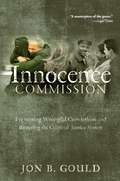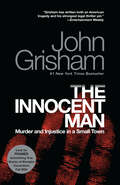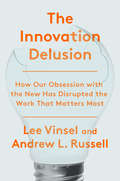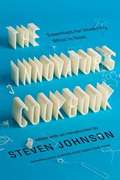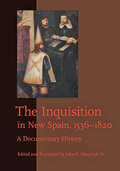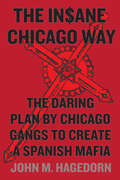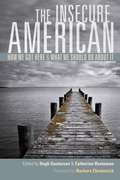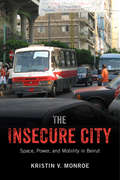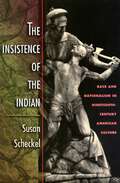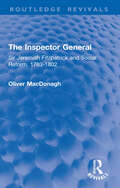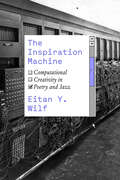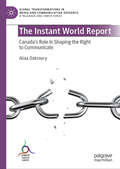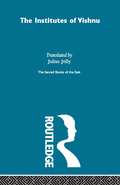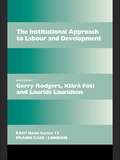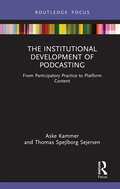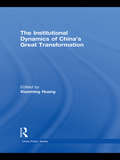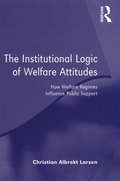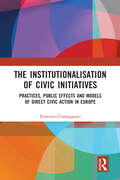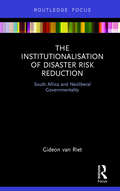- Table View
- List View
The Innocence Commission: Preventing Wrongful Convictions and Restoring the Criminal Justice System
by Jon B. GouldBeyond Exonerating the Innocent: Author on WAMU RadioConvicted Yet Innocent: The Legal Times ReviewChoice Outstanding Academic Title for 2008DNA testing and advances in forensic science have shaken the foundations of the U.S. criminal justice system. One of the most visible results is the exoneration of inmates who were wrongly convicted and incarcerated, many of them sentenced to death for crimes they did not commit. This has caused a quandary for many states: how can claims of innocence be properly investigated and how can innocent inmates be reliably distinguished from the guilty? In answer, some states have created “innocence commissions” to establish policies and provide legal assistance to the improperly imprisoned.The Innocence Commission describes the creation and first years of the Innocence Commission for Virginia (ICVA), the second innocence commission in the nation and the first to conduct a systematic inquiry into all cases of wrongful conviction. Written by Jon B. Gould, the Chair of the ICVA, who is a professor of justice studies and an attorney, the author focuses on twelve wrongful conviction cases to show how and why wrongful convictions occur, what steps legal and state advocates took to investigate the convictions, how these prisoners were ultimately freed, and what lessons can be learned from their experiences.Gould recounts how a small band of attorneys and other advocates — in Virginia and around the country — have fought wrongful convictions in court, advanced the subject of wrongful convictions in the media, and sought to remedy the issue of wrongful convictions in the political arena. He makes a strong case for the need for Innocence Commissions in every state, showing that not only do Innocence Commissions help to identify weaknesses in the criminal justice system and offer workable improvements, but also protect society by helping to ensure that actual perpetrators are expeditiously identified, arrested, and brought to trial. Everyone has an interest in preventing wrongful convictions, from police officers and prosecutors, who seek the latest and best investigative techniques, to taxpayers, who want an efficient criminal justice system, to suspects who are erroneously pursued and sometimes convicted.Free of legal jargon and written for a general audience, The Innocence Commission is instructive, informative, and highly compelling reading.
The Innocent Man: Murder and Injustice in a Small Town
by John Grisham#1 NEW YORK TIMES BESTSELLER • LOOK FOR THE NETFLIX ORIGINAL DOCUMENTARY SERIES • &“Both an American tragedy and [Grisham&’s] strongest legal thriller yet, all the more gripping because it happens to be true.&”—Entertainment Weekly John Grisham&’s first work of nonfiction: a true crime masterpiece that tells the story of small town justice gone terribly awry. In the Major League draft of 1971, the first player chosen from the state of Oklahoma was Ron Williamson. When he signed with the Oakland A&’s, he said goodbye to his hometown of Ada and left to pursue his dreams of big league glory. Six years later he was back, his dreams broken by a bad arm and bad habits. He began to show signs of mental illness. Unable to keep a job, he moved in with his mother and slept twenty hours a day on her sofa. In 1982, a twenty-one-year-old cocktail waitress in Ada named Debra Sue Carter was raped and murdered, and for five years the police could not solve the crime. For reasons that were never clear, they suspected Ron Williamson and his friend Dennis Fritz. The two were finally arrested in 1987 and charged with capital murder. With no physical evidence, the prosecution&’s case was built on junk science and the testimony of jailhouse snitches and convicts. Dennis Fritz was found guilty and given a life sentence. Ron Williamson was sent to death row. If you believe that in America you are innocent until proven guilty, this book will shock you. If you believe in the death penalty, this book will disturb you. If you believe the criminal justice system is fair, this book will infuriate you.Don&’t miss Framed, John Grisham&’s first work of nonfiction since The Innocent Man, co-authored with Centurion Ministries founder Jim McCloskey.
The Innocent Party
by Aimee Parkison"Aimee Parkison most often begins softly, slowly stripping away each layer of social interaction to get at what is numinous and frightening and necessary about living in the real world. These are stories both about the difficulty and the intense suddenness of human connection, about the profound link that exists between being in love and being alone."-Brian EvensonFrom "The Glass Girl":On certain evenings in dark motels, she could transform her lip into the edge of the bottle, imagining her face was made of amber glass and the men paused above her only to take a drink of breath. Over the years, men drank and drank until there were only two sips left inside. They began sucking the air out of the glass that grew warm in the wrong places because of heat radiating off their hands. The men's breath along with white feathers fell over autumn winds drifting through open windows.In this collection, Kurt Vonnegut Fiction Prize-winner Aimee Parkison's characters struggle to understand what happens when the innocent party becomes the guilty party. With magical realist flair, secrets are aired with dirty laundry, but the stains never come clean. Carol Anshaw writes, "Aimee Parkison offers a distinct new voice to contemporary fiction. Her seductive stories explore childhood as a realm of sorrows, and reveal the afflictions of adults who emerge from this private geography."Aimee Parkison has an MFA from Cornell University. She is associate professor of English at the University of North Carolina at Charlotte, where she teaches creative writing.
The Innocent Party (American Readers Series #17)
by Aimee Parkison"Aimee Parkison most often begins softly, slowly stripping away each layer of social interaction to get at what is numinous and frightening and necessary about living in the real world. These are stories both about the difficulty and the intense suddenness of human connection, about the profound link that exists between being in love and being alone."-Brian EvensonFrom "The Glass Girl":On certain evenings in dark motels, she could transform her lip into the edge of the bottle, imagining her face was made of amber glass and the men paused above her only to take a drink of breath. Over the years, men drank and drank until there were only two sips left inside. They began sucking the air out of the glass that grew warm in the wrong places because of heat radiating off their hands. The men's breath along with white feathers fell over autumn winds drifting through open windows.In this collection, Kurt Vonnegut Fiction Prize–winner Aimee Parkison's characters struggle to understand what happens when the innocent party becomes the guilty party. With magical realist flair, secrets are aired with dirty laundry, but the stains never come clean. Carol Anshaw writes, "Aimee Parkison offers a distinct new voice to contemporary fiction. Her seductive stories explore childhood as a realm of sorrows, and reveal the afflictions of adults who emerge from this private geography."Aimee Parkison has an MFA from Cornell University. She is associate professor of English at the University of North Carolina at Charlotte, where she teaches creative writing.
The Innovation Delusion: How Our Obsession with the New Has Disrupted the Work That Matters Most
by Andrew L. Russell Lee VinselInnovation is the hottest buzzword in business. But what if our obsession with finding the next big thing has distracted us from the work that matters most?&“The most important book I&’ve read in a long time . . . It explains so much about what is wrong with our technology, our economy, and the world, and gives a simple recipe for how to fix it: Focus on understanding what it takes for your products and services to last.&”—Tim O&’Reilly, founder of O&’Reilly Media It&’s hard to avoid innovation these days. Nearly every product gets marketed as being disruptive, whether it&’s genuinely a new invention or just a new toothbrush. But in this manifesto on thestate of American work, historians of technology Lee Vinsel and Andrew L. Russell argue that our way of thinking about and pursuing innovation has made us poorer, less safe, and—ironically—less innovative. Drawing on years of original research and reporting, The Innovation Delusion shows how the ideology of change for its own sake has proved a disaster. Corporations have spent millions hiring chief innovation officers while their core businesses tank. Computer science programs have drilled their students on programming and design, even though theoverwhelming majority of jobs are in IT and maintenance. In countless cities, suburban sprawl has left local governments with loads of deferred repairs that they can&’t afford to fix. And sometimes innovation even kills—like in 2018 when a Miami bridge hailed for its innovative design collapsed onto a highway and killed six people. In this provocative, deeply researched book, Vinsel and Russell tell the story of how we devalued the work that underpins modern life—and, in doing so, wrecked our economy and public infrastructure while lining the pockets of consultants who combine the ego of Silicon Valley with the worst of Wall Street&’s greed. The authors offer a compelling plan for how we can shift our focus away from the pursuit of growth at all costs, and back toward neglected activities like maintenance, care, and upkeep. For anyone concerned by the crumbling state of our roads and bridges or the direction our economy is headed, The Innovation Delusion is a deeply necessary reevaluation of a trend we can still disrupt.
The Innovator's Cookbook
by Steven JohnsonEssential reading-and progressive thinking-on the subject of innovation, from the national bestselling author. Steven Johnson, an acknowledged bestselling leader on the subject of innovation, gathers-for a foundational text on the subject of innovation-essays, interviews, and cutting-edge insights by such exciting field leaders as Peter Drucker, Richard Florida, Eric Von Hippel, Dean Keith Simonton, Arthur Koestler, John Seely Brown, and Marshall Berman. Johnson also provides new material from Marisa Mayer of Google, Twitter's Biz Stone and Jack Dorsey, and Ray Ozzie, Microsoft's former Chief Software Architect. With additional commentary by Johnson himself, this book reveals the innovation found in a wide range of fields, including science, technology, energy, transportation, education, art, and sociology, making it vital, fresh, and fascinating reading for our time, and for the future.
The Inquisition in New Spain, 1536–1820: A Documentary History
by John F. Chuchiak IVThe Inquisition! Just the word itself evokes, to the modern reader, endless images of torment, violence, corruption, and intolerance committed in the name of Catholic orthodoxy and societal conformity. But what do most people actually know about the Inquisition, its ministers, its procedures? This systematic, comprehensive look at one of the most important Inquisition tribunals in the New World reveals a surprisingly diverse panorama of actors, events, and ideas that came into contact and conflict in the central arena of religious faith.Edited and annotated by John F. Chuchiak IV, this collection of previously untranslated and unpublished documents from the Holy Office of the Inquisition in New Spain provides a clear understanding of how the Inquisition originated, evolved, and functioned in the colonial Spanish territories of Mexico and northern Central America. The three sections of documents lay out the laws and regulations of the Inquisition, follow examples of its day-to-day operations and procedures, and detail select trial proceedings. Chuchiak’s opening chapter and brief section introductions provide the social, historical, political, and religious background necessary to comprehend the complex and generally misunderstood institutions of the Inquisition and the effect it has had on societal development in modern-day Mexico, Guatemala, El Salvador, Nicaragua, and Honduras. Featuring fifty-eight newly translated documents, meticulous annotations, and trenchant contextual analysis, this documentary history is an indispensable resource for anyone seeking to understand the Inquisition in general and its nearly three-hundred-year reign in the New World in particular.
The Insane Chicago Way: The Daring Plan by Chicago Gangs to Create a Spanish Mafia
by John M. HagedornThe Insane Chicago Way is the untold story of a daring plan by Chicago gangs in the 1990s to create a Spanish Mafia--and why it failed. John M. Hagedorn traces how Chicago Latino gang leaders, following in Al Capone's footsteps, built a sophisticated organization dedicated to organizing crime and reducing violence. His lively stories of extensive cross-neighborhood gang organization, tales of police/gang corruption, and discovery of covert gang connections to Chicago's Mafia challenge conventional wisdom and offer lessons for the control of violence today. The book centers on the secret history of Spanish Growth & Development (SGD)--an organization of Latino gangs founded in 1989 and modeled on the Mafia's nationwide Commission. It also tells a story within a story of the criminal exploits of the C-Note$, the "minor league" team of the Chicago's Mafia (called the "Outfit"), which influenced the direction of SGD. Hagedorn's tale is based on three years of interviews with an Outfit soldier as well as access to SGD's constitution and other secret documents, which he supplements with interviews of key SGD leaders, court records, and newspaper accounts. The result is a stunning, heretofore unknown history of the grand ambitions of Chicago gang leaders that ultimately led to SGD's shocking collapse in a pool of blood on the steps of a gang-organized peace conference. The Insane Chicago Way is a compelling history of the lives and deaths of Chicago gang leaders. At the same time it is a sociological tour de force that warns of the dangers of organized crime while arguing that today's relative disorganization of gangs presents opportunities for intervention and reductions in violence.
The Insecure American: How We Got Here and What We Should Do About It
by Hugh Gusterson Catherine BestemanAmericans are feeling insecure. They are retreating to gated communities in record numbers, fearing for their jobs and their 401(k)s, nervous about their health insurance and their debt levels, worrying about terrorist attacks and immigrants. In this innovative volume, editors Hugh Gusterson and Catherine Besteman gather essays from nineteen leading ethnographers to create a unique portrait of an anxious country and to furnish valuable insights into the nation's possible future. With an incisive foreword by Barbara Ehrenreich, the contributors draw on their deep knowledge of different facets of American life to map the impact of the new economy, the "war on terror," the "war on drugs," racial resentments, a fraying safety net, undocumented immigration, a health care system in crisis, and much more. In laying out a range of views on the forces that unsettle us, The Insecure American demonstrates the singular power of an anthropological perspective for grasping the impact of corporate profit on democratic life, charting the links between policy and vulnerability, and envisioning alternatives to life as an insecure American.
The Insecure City: Space, Power, and Mobility in Beirut
by Kristin V. MonroeFifteen years after the end of a protracted civil and regional war, Beirut broke out in violence once again, forcing residents to contend with many forms of insecurity, amid an often violent political and economic landscape. Providing a picture of what ordinary life is like for urban dwellers surviving sectarian violence, The Insecure City captures the day-to-day experiences of citizens of Beirut moving through a war-torn landscape. While living in Beirut, Kristin Monroe conducted interviews with a diverse group of residents of the city. She found that when people spoke about getting around in Beirut, they were also expressing larger concerns about social, political, and economic life. It was not only violence that threatened Beirut's ordinary residents, but also class dynamics that made life even more precarious. For instance, the installation of checkpoints and the rerouting of traffic--set up for the security of the elite--forced the less fortunate to alter their lives in ways that made them more at risk. Similarly, the ability to pass through security blockades often had to do with an individual's visible markers of class, such as clothing, hairstyle, and type of car. Monroe examines how understandings and practices of spatial mobility in the city reflect social differences, and how such experiences led residents to be bitterly critical of their government. In The Insecure City, Monroe takes urban anthropology in a new and meaningful direction, discussing traffic in the Middle East to show that when people move through Beirut they are experiencing the intersection of citizen and state, of the more and less privileged, and, in general, the city's politically polarized geography.
The Inside Songs of Amiri Baraka (Palgrave Studies in Music and Literature)
by Aldon Lynn NielsenThe Inside Songs of Amiri Baraka examines the full length of Baraka’s discography as a poet recording with musicians as well as his contributions to jazz and R & B, beginning with his earliest studio recordings in 1965 and continuing to the last year of his life, 2014. This recorded history traces his evolution from the era of Beat poetry and “projective verse,” through the period of the Black Arts Movement and cultural nationalism, and on to his commitments to “third world Marxism,” which characterized the last decades of his life. The music enfolding Baraka’s recitations ranges from traditional African drumming, to doo wop, rhythm and blues, soul and the avant garde jazz that was his great love and the subject of so much of his writing, and includes both in-studio sessions and live concert performances. This body of work offers a rare opportunity to think about not only jazz/poetry, but the poet in the recording studio and the relations of text to score.
The Insider's Guide to the Peace Corps: What to Know Before You Go
by Dillon BanerjeeSo, you want to join the Peace Corps . . . If you are interested in joining the Peace Corps, you probably have questions that run the gamut from "What is the application process like?" to "Is the Peace Corps effective as a development agency?" In this updated second edition, former Peace Corps volunteer Dillon Banerjee shares candid facts and insights about the experience in a practical question-and-answer format. With input from recently returned volunteers who served across the globe, this thorough guide presents valuable information including: * What Peace Corps recruiters look for in your application* Items you should--and shouldn't---pack for your two-year trip* Useful gadgets and technology that help volunteers stay connected from far away* Real answers to personal questions about culture shock, safety, dating, homesickness, and more Whether you're thinking of joining or have already been accepted and are preparing to leave, The Insider's Guide to the Peace Corps will help equip you for the unique challenges and rewards of the volunteer experience, regardless of your program area or country assignment. It's essential reading for anyone interested in "the toughest job you'll ever love." From the Trade Paperback edition.
The Insistence of the Indian: Race and Nationalism in Nineteenth-Century American Culture
by Susan ScheckelAmericans' first attempts to forge a national identity coincided with the apparent need to define--and limit--the status and rights of Native Americans. During these early decades of the nineteenth century, the image of the "Indian" circulated throughout popular culture--in the novels of James Fenimore Cooper, plays about Pocahontas, Indian captivity narratives, Black Hawk's autobiography, and visitors' guides to the national capitol. In exploring such sources as well as the political and legal rhetoric of the time, Susan Scheckel argues that the "Indian question" was intertwined with the ways in which Americans viewed their nation's past and envisioned its destiny. She shows how the Indians provided a crucial site of reflection upon national identity. And yet the Indians, by being denied the natural rights upon which the constitutional principles of the United States rested, also challenged American convictions of moral ascendancy and national legitimacy.Scheckel investigates, for example, the Supreme Court's decision on Indian land rights and James Fenimore Cooper's popular frontier romance The Pioneers: both attempted to legitimate American claims to land once owned by Indians and to assuage guilt associated with the violence of conquest by incorporating the Indians in a version of the American political "family." Alternatively, the widely performed Pocahontas plays dealt with the necessity of excluding Indians politically, but also portrayed these original inhabitants as embodying the potential of the continent itself. Such examples illustrate a gap between principles and practice. It is from this gap, according to the author, that the nation emerged, not as a coherent idea or a realist narrative, but as an ongoing performance that continues to play out, without resolution, fundamental ambivalences of American national identity.
The Inspector General: Sir Jeremiah Fitzpatrick and Social Reform, 1783-1802 (Routledge Revivals)
by Oliver MacDonaghSir Jeremiah Fitzpatrick (c.1740-1810) was the first inspector general of prisons and lunacy inspector in Ireland and the first and only inspector of health to HM land forces in Great Britain. He also inspected convict vessels bound for New South Wales and the East India Company‘s troop ships, inquired into the Irish Charter Schools and attempted to alleviate the miseries of soldiers’ dependents. His further ambitions ranged from a poor law for Ireland to a reorganisation of Dublin’s police, to the regulation of noxious trades, from slave trade inspectorates to hospital management. He was therefore in many ways a precursor of the titans of early and mid-Victorian government. Originally published in 1981, much of the interest of the book lies in its revelation of late eighteenth century anticipations of mid-nineteenth century government. It also explores the differences between the two forms of administration and the reasons for the divergences and discontinuities.
The Inspiration Machine: Computational Creativity in Poetry and Jazz
by Eitan Y. WilfExplores how creative digital technologies and artificial intelligence are embedded in culture and society. In The Inspiration Machine, Eitan Y. Wilf explores the transformative potentials that digital technology opens up for creative practice through three ethnographic cases, two with jazz musicians and one with a group of poets. At times dissatisfied with the limitations of human creativity, these artists do not turn to computerized algorithms merely to execute their preconceived ideas. Rather, they approach them as creative partners, delegating to them different degrees of agentive control and artistic decision-making in the hopes of finding inspiration in their output and thereby expanding their own creative horizons. The algorithms these artists develop and use, however, remain rooted in and haunted by the specific social predicaments and human shortfalls that they were intended to overcome. Experiments in the digital thus hold an important lesson: although Wilf’s interlocutors returned from their adventures with computational creativity with modified, novel, and enriched capacities and predilections, they also gained a renewed appreciation for, and at times a desire to re-inhabit, non-digital creativity. In examining the potentials and pitfalls of seemingly autonomous digital technologies in the realm of art, Wilf shows that computational solutions to the real or imagined insufficiencies of human practice are best developed in relation to, rather than away from, the social and cultural contexts that gave rise to those insufficiencies, in the first place.
The Instant World Report: Canada's Role in Shaping the Right to Communicate (Global Transformations in Media and Communication Research - A Palgrave and IAMCR Series)
by Aliaa DakrouryThis book proposal focuses on Canada's pioneering role in shaping the international understanding of the right to communicate, particularly through the Canadian Telecommission Studies of 1969. The study argues that the 1971 Instant World report, a landmark document, has been overlooked in the existing literature despite its importance in the history of conceptualizing and implementing this human right. The project aims to fill this gap by exploring the historical context of the report and analyzing its contents, shedding light on themes like privacy and indigenous communication rights. Additionally, the manuscript highlights the unique contribution of Betty Zimmerman, the only female Canadian member of the MacBride Commission in 1977, replacing Marshall McLuhan. Zimmerman's insights become pertinent not only for scholars interested in the New World Information and Communication Order but also for feminist studies, showcasing a leading female figure's role in Canadian communication and cultural policy. The research promises a novel and untold perspective on the history of the right to communicate, addressing gaps in international and Canadian communication, women’s studies, and media policy literature.
The Institutes of Vishnu: The Sacred Books Of The East V7
by Julius JollyThis is a subset of F. Max Mullers great collection The Sacred Books of the East which includes translations of all the most important works of the seven non-Christian religions which have exercised a profound influence on the civilizations of the continent of Asia. The works have been translated by leading authorities in their field.
The Institutional Approach to Labour and Development (Routledge Research EADI Studies in Development #No. 17)
by Gerry Rodgers Klárá Fóti Laurids LauridsenBringing together the work of economists and sociologists in research programmes in a number of European institutions concerned with development, this collection analyses how social institutions contribute to an understanding of development.It shows how labour markets, labour relations and employment patterns respond to institutional forces, and thereby shape development paths and determine how different groups benefit from economic growth.
The Institutional Development of Podcasting: From Participatory Practice to Platform Content (Disruptions)
by Aske Kammer Thomas Spejlborg SejersenReferring back to the early 2000s, this book traces the development of podcasting from a “do-it-yourself” medium by amateurs into its current environment, where a wide variety of individuals, organizations, and platforms operate in an increasingly crowded and competitive market.Through original case studies of shows and platforms including "The Daily" and Spotify, the authors explore the processes and effects of commercialization, platformization, and datafication in the industry. Drawing on institutional theory and the growing body of scholarly literature about podcasting, they examine the shifts and reorientations in institutional logics that characterize podcasting and present the different types of actors that operate in the commercial and noncommercial podcast markets.The Institutional Development of Podcasting will be of interest to advanced students and researchers of audio media, journalism, and media industries.
The Institutional Dynamics of China's Great Transformation (China Policy Series)
by Xiaoming HuangThis book examines the role of institutions in China’s recent large-scale economic, social and political transformation. The book argues that, although the importance of institutions in China’s rapid economic growth and social development over the past 30 years is widely acknowledged, exactly how institutions affect changes in particular national and historical settings is less well understood. Unlike existing literature, it offers perspectives from a variety of disciplines - including law, economics, politics, international relations and communication studies – to consider whether institutions form, evolve and change differently according to their historical or cultural environments and if their utilitarian functions can, and should be, observed, identified and measured in different ways. The book discusses China’s political and legal institutions; the international institutions with which China engages; institutions promoting science and technology; media companies; and local institutions including the household registration system. It also examines how institutions themselves have been formed, changed and re-formed over recent decades, and suggests theoretical and methodological adjustments in institutional analysis to allow a fuller understanding of the institutional dynamics of China’s transformation.
The Institutional Dynamics of Culture, Volumes I and II: The New Durkheimians (The International Library of Essays in Anthropology)
by Perri 6These two volumes present the most important recent developments in the institutional theory of culture and demonstrate their practical applications. Sometimes called 'grid-group analysis' or 'cultural theory', they derive from the work of Durkheim in the 1880s and 1900s and develop the insights of the anthropologist Mary Douglas and her followers from the 1960s on. First redefined within social and cultural anthropology, the theory's influence is shown in recent years to have permeated all the main disciplines of social science with substantial implications for politics, history, business, work and organizations, the environment, technology and risk, and crime and consumption. Today, the institutional theory of culture now rivals the rational choice, Weberian and postmodern outlooks in influence across the social sciences.
The Institutional Logic of Welfare Attitudes: How Welfare Regimes Influence Public Support
by Christian Albrekt LarsenWhy are people who live in liberal welfare regimes reluctant to support welfare policy? And conversely, why are people who live in social democratic welfare regimes so keen to support it? These core questions lie at the heart of this intriguing book. By examining how different welfare regimes influence public support for welfare policy, the book explores the institutional settings of different regimes and how each produces its own support. While previous studies in this field have failed to link the macro-structure of welfare regimes and the micro-structure of welfare attitudes, this book redresses this problem by combining welfare regime theory and literature on deservingness criteria alongside empirical evidence from national and cross-national data. While recent trends in welfare state development such as cuts in benefit levels and increased use of targeting, combined with increased immigration, might very well influence our perceptions of the deservingness of the needy, this book provides a strong, convincing and provoking argument that challenges the micro-foundation of present comparative welfare state theory. The result is an important work for all studying and working in the fields of public policy and social welfare.
The Institutional Origins of Communal Violence
by Yuhki TajimaWhy are transitions from authoritarian rule often marked by spikes in communal violence? Through examining Indonesia's recent transition to democracy, this book develops a novel theoretical explanation for this phenomenon that also accounts for why some communities are vulnerable to violence during such transitions while others are able to maintain order. Yuhki Tajima argues that repressive intervention by security forces in Indonesia during the authoritarian period rendered some communities dependent on the state to maintain intercommunal security, whereas communities with a more tenuous exposure to the state developed their own informal institutions to maintain security. As the coercive grip of the authoritarian regime loosened, communities that were more accustomed to state intervention were more vulnerable to spikes in communal violence until they developed informal institutions that were better adapted for less state intervention. To test the theory, Tajima employs extensive fieldwork in, and rigorous statistical evidence from, Indonesia as well as cross-national data.
The Institutionalisation of Civic Initiatives: Practices, Public Effects and Models of Direct Civic Action in Europe
by Francesco CampagnariThis book examines two civic initiatives in Europe and analyses their evolution through the institutionalisation of their practices, local public effects, and established models for action at broader scales.Drawing from the concepts of civic action, problematic situations, public problems, and experience, this book coins the concept of direct civic action to explore civic initiatives beyond sectorial categories. It draws from the histories, everyday activities, and encounters with new problematic situations of a Slovak and a French initiative. It analyses the institutionalisation of their internal practices, their public cultural services, the models for action they establish in broader networks of initiatives, and how institutionalisation affects their experimentation and innovation. This book uses two case studies of civic initiatives in France and Slovakia, examining how the experimental and institutionalised approaches to problematic situations of civic initiatives are associated with the generation and continuative reproduction of public goods and policies. It also explores how local initiatives establish national and international networks and models for direct civic action.This book is aimed at scholars interested in civic initiatives, urban planning, public policies, innovation studies, and urban sociology. It is intended to engage members of civic initiatives by offering insights into organisational dynamics and their impact on public issues. Furthermore, it appeals to public officials and policy-makers who aim to establish policies that promote civic initiatives and encourage direct civic action.
The Institutionalisation of Disaster Risk Reduction: South Africa and Neoliberal Governmentality (Routledge Studies in Hazards, Disaster Risk and Climate Change)
by Gideon van RietThe past three decades have seen a global shift in disaster management from an event driven response to a ‘could-be’ risk management approach. Disaster risk reduction (DRR) has become entrenched as a dominant paradigm within the field of disaster management. More than a decade after adopting DRR legislation in South Africa there remains a dearth of evidence that this has translated into substantive action. This book examines the institutionalisation of DRR in South Africa, conceived of as a political economy of knowledge production. Using a critical theory approach, the book does not consider why DRR is failing but instead asks ‘why DRR?’ As such, it explores possibilities beyond DRR’s narrow optic and offers new insights into disaster management through the lens of South Africa. This is valuable reading for graduate students and academics working in disaster studies, geography, public policy and development/post-development studies, as well as policy makers.
